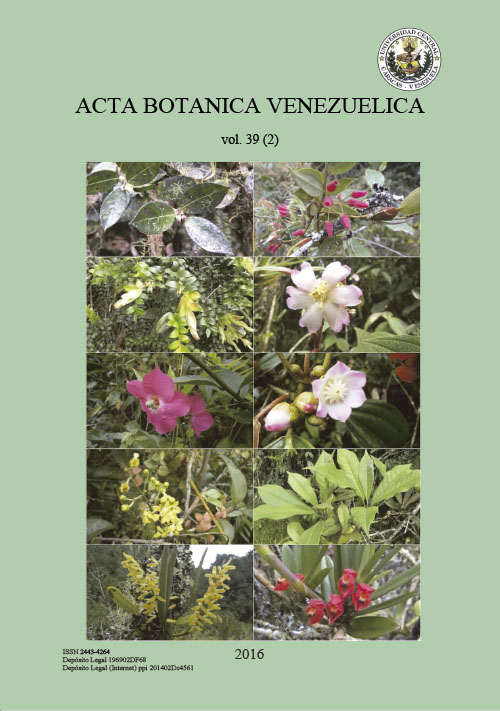BIOGEOGRAPHICAL STUDIES OF VENEZUELAN SPECIES OF STYLOSANTHES (LEGUMINOSAE)
Resumen
Stylosanthes is a mainly Neotropical genus comprising ca. 25 species with Venezuela hosting high species richness. Despite of the economic importance of some species as forage legumes, the biogeography of Stylosanthes in Venezuela has hitherto been poorly studied. Information of herbarium specimens and germplasm accessions was collated in order to assess distribution, range size, geographic species richness and rarity in the country. Stylosanthes guianensis has the widest geographical distribution and the largest range size. The highest species richness occurs in the eastern plains (“Llanos”) (7-10° N, 62-65° W). The endemic S. sericeiceps and S. venezuelensis fall within the rarest category. This study contributes to better understand the pattern of biogeographical variation of Venezuelan Stylosanthes species, and can help to design conservation strategies.
Descargas
Citas
-Calles, T. & R. Schultze-Kraft. 2010. Stylosanthes (Leguminosae, Dalbergieae) of Venezuela. Willdenowia 40: 305-329.
-Calles, T., R. Schultze-Kraft & O. Guenni. 2016. Exploration and conservation of Stylosanthes (Leguminosae) genetic resources in Venezuela. Genet. Resour. Crop. Evol.; DOI: 10.1007/s10722-015-0359-7.
-Chakraborty, S. (ed.). 2004. High-yielding anthracnose-resistant Stylosanthes for agricultural systems. Australian Centre for International Agricultural Research. Canberra, Australia.
-Costa, N.M.S. & M.B. Ferreira. 1984: Some Brazilian species of Stylosanthes. In: The biology and agronomy of Stylosanthes (Stace, H.M. & L.A. Edye, eds.), pp. 53-101. Academic Press. Sydney. Australia.
-Cox, C.B. & P.D. Moore. 2000. Biogeography: an ecological and evolutionary approach. Sixth edition. Blackwell Science. Oxford, England.
-Ferrer-Paris, J.R. & J.P. Rodríguez. 2010. Cuadrícula para el estudio de la distribución espacial de la biodiversidad terrestre en Venezuela. Versión 1.1. Instituto Venezolano de Investigaciones Científicas. Caracas, Venezuela.
-Guenni, O., T. Calles, J.L. Gil, J. Fariñas, I. Rodríguez, F. Espinoza, D. Sanabria & R. -Schultze-Kraft. 2006. Collecting native forage legume (Centrosema, Stylosanthes and Desmodium) germplasm in Venezuela. Plant Genet. Resour. Newsl. 148: 38-43.
-Huber, O. & C. Alarcón. 1988. Mapa de la vegetación de Venezuela. Ministerio del Ambiente y de los Recursos Naturales Renovables. Caracas, Venezuela.
-Hunter, J.T. 2005. Phytogeography, range size and richness of Australian endemic Sauropus (Euphorbiaceae). J. Biogeogr. 32: 63-73.
-IUCN (International Union for Conservation of Nature). 2001. IUCN Red list of threatened species: categories and criteria. Version 3.1. IUCN Species Survival Commission and International Union for Conservation of Nature, Gland and Cambridge.
-Klitgaard, B.B. & M. Lavin. 2005. Tribe Dalbergieae sensu lato. In: Lewis, G., B. Schrire, B. Mackinder & M. Lock (eds.). Legumes of the world, pp. 307-335. Royal Botanic Gardens. Kew, England.
-Llamozas, S., R. Duno, W. Meier, R. Riina, F. Stauffer, G. Aymard, O. Huber & R. Ortiz. 2003. Libro rojo de la flora venezolana. Provita, Fundación Empresas Polar, Fundación Instituto Botánico de Venezuela, Conservation International. Caracas, Venezuela.
-Mannetje, L. ’t. 1984. Considerations on the taxonomy of the genus Stylosanthes. In: Stace, H.M. & L.A. Edye (eds.). The biology and agronomy of Stylosanthes, pp. 1-21. Academic Press. Sydney, Australia.
-MARN (Ministerio del Ambiente y los Recursos Naturales). 2000. Primer informe de Venezuela sobre diversidad biológica. Ministerio del Ambiente y de los Recursos Naturales. Caracas, Venezuela.
-McIntyre, S. 1992. Risks associated with the setting of conservation priorities from rare plant species lists. Biol. Conserv. 60: 31-37.
-Nooteboom, H.P. 1961. Stylosanthes Swartz. Reinwardtia 5: 446-450.
-Rabinowitz, D. 1981. Seven forms of rarity. In: Synge, H. (ed.). The biological aspects of rare plant conservation,pp. 205-217. John Wiley & Sons. Chichester, United Kingdom.
-Rabinowitz, D., S. Cairns & T. Dillon. 1986. Seven forms of rarity and their frequency in the flora of the British Isles. In: Soulé, M.E. (ed.). Conservation biology: the science of scarcity and diversity, pp. 182-204. Sinauer Associates. Sunderland, Massachusetts, USA.
-Schultze-Kraft, R., R. Reid, R.J. Williams & L. Coradin. 1984. The existing Stylosanthes collections. In: Stace, H.M. & L.A. Edye (eds.). The biology and agronomy of Stylosanthes, pp. 125-146. Academic Press. Sydney, Australia.
-Stace, H.M. & D.F. Cameron. 1984. Cytogenetics and the evolution of Stylosanthes. In: Stace, H.M. & L.A. Edye (eds.). The biology and agronomy of Stylosanthes, pp. 49-72. Academic Press. Sydney, Australia.
-Stace, H.M. & L.A. Edye (eds.). 1984. The biology and agronomy of Stylosanthes. Academic Press. Sydney, Australia.
-Steyermark, J.A., P.E. Berry, B. Holst & K. Yatskievych. 1995‒2005 [nine volumes]. Flora of the Venezuelan Guayana. Missouri Botanical Garden Press. Saint Louis, USA.
-Terborgh, J. & B. Winter. 1980. Some causes of extinction. In: Soulé, M.S. & B.A. Wilcox (eds.). Conservation Biology: an evolutionary-ecological perspective, pp. 119-133. Sinauer Associates. Sunderland, USA.
-Thiers, B. 2008+ [continuously updated]. Index Herbariorum: a global directory of public herbaria and associated staff. Published at http://sweetgum.nybg.org/ih/. New York Botanical Garden. New York, USA.
Descargas
Número
Sección
Licencia
© Instituto Experimental Jardín Botánico "Dr. Tobías Lasser" |


